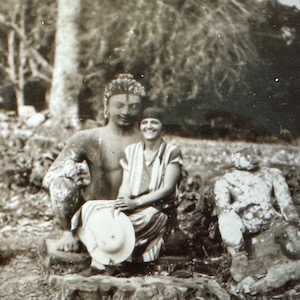Travel Writing, Spectacle and World History
Travel Writing, Spectacle and World History (TWSWH) is a digitized collection of travel sources created by 19th- and 20th-century American women. These materials come from the Schlesinger Library at the Radcliffe Institute for Advanced Study, Harvard University. Types of materials include correspondence, letters, diaries, ephemera, journals, guidebooks, photographs, drawings, postcards, and manuscripts. The geographic range of destinations for women is considerable. England, France, Italy, and Germany are the most frequently covered destinations, then China, India and Japan are also well documented. In many of these accounts, American women compare themselves to women in the places they visit, reflect on what they are missing at home, adjust to different customs, and find themselves in the public arena for the first time.
The website’s interface is very user-friendly and easily navigable. The main screen is topped by a simple search box and tool bar which divided between "Introduction," "View All Documents," "Visual Gallery," "Maps," "Searching Guide," and "Research Tools." The section "View All Documents" and "Visual Gallery" provide a wealth of primary source material--both documents and visual sources to users. In total these sections contain 242 digital documents and 301 visual sources. Users can search the documents through the date, topics, region, country, or travelers' names in alphabetical order. However, unlike other websites designed by Adam Matthew Digital, users cannot search the documents through the type, and they can only search the visual sources through the name of the traveler which may create an obstacle for students. Each entry contains the name of the traveler, the title of the material, the reference to the original, the date of the material, the regions mentioned, and very detailed biographical information. Teachers and students may export the citation directly into EndNote or RefWorks. For teaching or presentation purposes, teachers can also easily create slide shows using the database's visual materials.
There are two tabs under the "Maps" section: the first one is "Interactive World Map," which allows users to explore the major destinations of the travelers. After choosing the name of the travelers on the menu, the map will mark all locations where have been visited by that traveler. The location contains hyperlinks which can direct users to the page that contains all documents related to this specific region/country. The second one is "Case Study Maps," which contains maps of six selected travelers in the collection, every map shows its traveler's route and date in detail, also includes the brief information of the travelers. The text panel excerpts the traveler's writings and links to relevant archival documents. Finally, the section "Research Tools" provides a series of useful tabs, especially for the "Popular Searches" feature, which lets users search by keywords, traveler, title, or Summary and allows for word stemming, proximity, and limiting by date. The tab "Chronology" situates the travelers in their historical context with one chronology from 1770 to 1976. By selecting four different periods, users can explore how those women's travel experiences interwove with important historical events, and understanding the history of travel from an American perspective. In entries, click on a traveler's name to link to a document relevant to the topic discussed.
Travel Writing, Spectacle and World History provides valuable tools with which to teach world history. Students can think about what it is about a particular place or certain events that shaped these women’s views of the places they travelled. How women widen their political and cultural horizons through traveling? Students can also learn about women’s reactions to the opportunities provided to them to move out of their familial surroundings and participate in what had hitherto been considered to be essentially male domains such as traveling to war zones. Thematic comparisons can also be made among travel in different time periods, exposure to different events or the way in which different individuals reacted to the same place and its people. For example, both of Julia Deane and Ida Pruitt had been visited China. Deane visited China as an ordinary traveler, Pruitt was born in China as a daughter of missionaries. Spending her childhood and early adulthood in China, she returned to the United States to be educated, and graduated from Cox College. Perhaps most interesting is her 1959-60 trip, made during a time when the United States did not officially recognize the People’s Republic of China, so placing it off-limits to most Americans. She includes travel tips for the eager tourists and business travelers who enter China following its “opening” to US citizens in the 1970s. Teachers may require students to read and compare these two traveler's works, and then asking the following questions: In what way are Julia Deane’s 1920s observations of Chinese life different from those of Ida Pruitt in the late 1950s and 1970s, and what do the differences tell us about China? About Western attitudes to China? About Chinese attitudes to the West? And if there is no satisfactory answer to the latter question, why not? Overall, this database is a digital archive centered on women’s profound interests in coming to know their world, and their desire to live in liminal spaces, to witness events of great importance, and to do valuable work. Both the contents and the remarkably accessible and agile design made TWSWH an essential resource for scholars and students of world history, tourism and travel history, women's studies, and ethnic and cultural studies.
